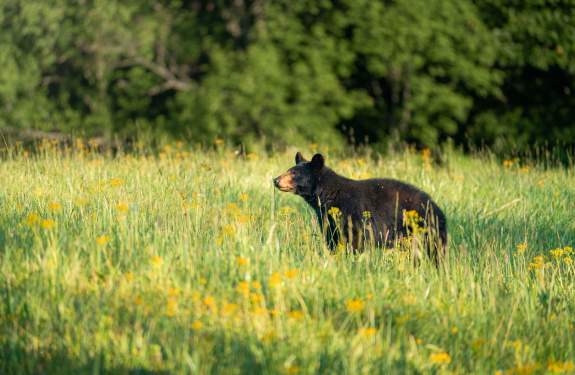If you’re heading out to get away from it all, chances are good you’re heading into bear country. If you don’t live with bears at home (or even if you do), it’s good to get BearWise before you hit the road.
Bears are never on vacation. Bears can’t pack up and get away from people; bears that live in areas that are popular vacation destinations must learn how to make a living while doing their best to avoid both the locals and a steady stream of visitors who often don’t know much about bears.
Bears are always looking for food. They have noses that can smell lunch from a mile away and the tastebuds of the average two-year-old; they’ll eat just about anything, including stuff that’s not even food. Some simple precautions will keep bears out of your vehicle, your home away from home and your garbage, leftovers, and picnic lunch.
Garbage, Yum!
Back to Top of List Bears are attracted to trash because it smells great (to a bear) and is usually full of food. Dispose of your trash in a secure container and don’t forget to close and latch the lid. Bears can open unlatched lids with a flip of the paw. Resist the temptation to leave your trash piled up next to the trash can or dumpster; if it’s full, do the bear-responsible thing and take it with you or keep it inside until you can dispose of it properly.
Bears are attracted to trash because it smells great (to a bear) and is usually full of food. Dispose of your trash in a secure container and don’t forget to close and latch the lid. Bears can open unlatched lids with a flip of the paw. Resist the temptation to leave your trash piled up next to the trash can or dumpster; if it’s full, do the bear-responsible thing and take it with you or keep it inside until you can dispose of it properly.
Don’t Toss Your Trash
Back to Top of ListThrowing food, wrappers, or trash out the car window isn’t just messy and illegal; trying to get to your tossed-away goodies can get bears killed. Tossing scraps behind your cabin encourages bears and other unwelcome critters to hang around homes and investigate. Bears are smart. They usually figure out there’s probably more food where that came from.
Dogs + Bears = Trouble
Back to Top of ListDogs are involved in the majority of all physical encounters between people and black bears. By nature, black bears are neither confrontational nor aggressive, but dog behavior is more complex. If your dog gets into an encounter with a bear, there’s about a fifty percent chance it will be injured or killed. And an even higher chance you’ll be injured if you intervene. If you’re going to spend lots of time in the woods, the safest thing to do is leave your pet at home. If you choose to bring your dog to bear country, keep your pet on a non-retractable leash whenever you are outdoors, even if you’re just going from your cabin to the car or letting your dog out in an unfenced area. Bears don’t like to be surprised. Never let your pet out into the yard without taking a good look around first, especially at night. Letting your dog approach or bark aggressively at a bear might make you feel safe, but in reality, you’re putting yourself and your pet in danger. Download our dog safety 2-page bulletin or 1-page poster.
Guard Your Stuff
Back to Top of ListIt only takes a few seconds for an enterprising bear to swipe your food, trash, or pet food. Avoid leaving food, snacks, trash, or pet food outdoors when no one is around. If you’re hiking, pack it in and pack it out, even if it’s biodegradable and seems harmless. Leaving banana peels, sandwich crusts, and apple cores along trails encourages bears to hang out in hopes of more food rewards.
Discourage Break-Ins
Back to Top of ListTo a bear, your screen door or open car window is an invitation to drop in for dinner.
- Lock vehicles, and don’t leave windows open even a crack. Bears are very strong, with nimble claws that can easily peel down the window.
- Remove anything with an odor from your vehicle, including all food, drinks, trash, pet food, and anything that smells, such as gum, air fresheners, suntan lotion, and scented toiletries. If it still smells like a food truck, spray the inside with an unscented sanitizer.
- Keep porches and decks clean; they’re not safe places to leave food, trash, recycling, beverages, or coolers.
- Close and lock your doors at night. Ask your host if there have been bear visits in your area. If the answer is yes, close and lock all bear-accessible windows, not just those on the ground floor.
If You Encounter A Bear
Back to Top of ListIf you spot a bear nosing around a dumpster or by a building, don’t approach or corner it. As long as the bear has an escape route and you are in a safe location, make noise and try to scare it away.
If a bear comes by to investigate your cabin, don’t offer it food or try to encourage it to hang around so you can take more photos. Do yourself and everyone who will stay in your cabin after you leave a big favor and try to scare the bear away. Make lots of noise, yell, clap your hands, or bang pots and pans together from a safe distance.
If you forgot to lock the cabin and come home to discover a bear rummaging through the kitchen cupboards, leave and call 911.
If you plan to go hiking, camping, or spend time out in the woods, visit our Bear Safety Tips – Encounters page. Also, download the BearWise Outdoor Safety Tips.
Get BearWise. Have Fun. Go Home Happy.
Back to Top of ListOn behalf of all the bears and all the people who live where you’re going, thanks for taking the time to find out how to have a great vacation in Bear Country. You’ll be helping to keep bears wild, you and your family safe and visitors welcome.
Article reposted with permission
Copyright © 2018-2021 BearWise | All Rights Reserved. To reprint, redistribute or excerpt without changing or altering content in any way, please credit: Courtesy of BearWise® | www.BearWise.org
Black Bears in Gatlinburg
An iconic symbol of the Smokies, the American Black Bear, is perhaps the most famous resident of Great Smoky Mountains National Park with approximately 1,500 bears living in the park. While seeing a bear is a wonderful experience, it's important to always be "bear aware."







